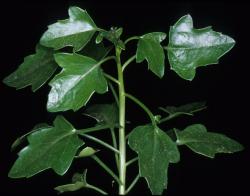- Taxon
- Weed
- Gallery
Glabrous, scandent, perennial herb, sometimes forming a dense tangled shrub up to 2 m tall. Stems usually sparingly branched. Lvs petiolate; petiole ± = lamina, not amplexicaul; lamina not lobed, ovate to deltoid, obtuse to acute, mucronate, obtuse to truncate at base, coarsely toothed with 1–3, convex-sided teeth on each side and lowermost teeth often distinctly larger, c. 30–60 × 25–50 mm; venation palmate-pinnate. Uppermost lvs becoming smaller, narrower, with fewer teeth or entire. Capitula in open, terminal panicles. Supplementary bracts 4–7, linear to subulate, 1.5–2.5 mm long. Involucral bracts 8–11, oblong, 5–6 mm long. Ray florets (4)–5; ligules yellow, 6–11 mm long. Disc yellow. Achenes terete, with hairs on ribs, c. 4 mm long; pappus 5–7 mm long.
[From: Webb et al. (1988) Flora of New Zealand. Volume 4.]
Flowering: Mar.–Aug.




